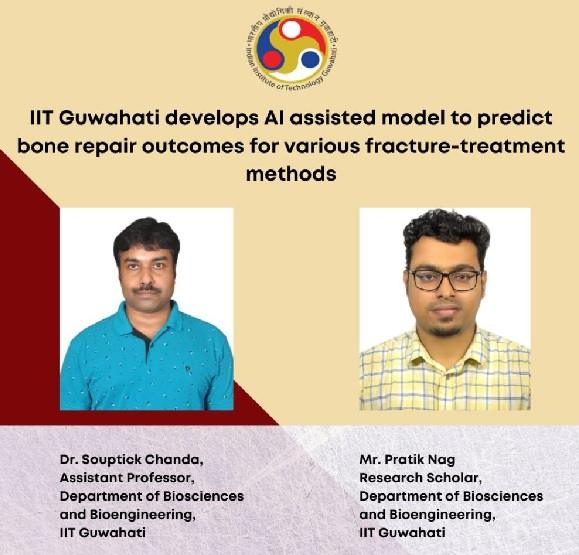
Guwahati: Indian Institute of Technology Guwahati researchers have developed Artificial Intelligence (AI) model to predict the healing of thigh bone fractures after surgery. The model developed by Dr. Souptick Chanda, Assistant Professor, Department of Biosciences and Bioengineering, IIT Guwahati, and his team can be used to assess the healing outcomes of different fracture fixation strategies so that an optimum strategy can be chosen for the patient depending on their personal physiologies and fracture type. Using such precision models can reduce the healing time, lighten the economic burden and pain for patients who need thigh fracture treatment.
The results of this research have recently been published in the open-source journal, PLoS One, in a paper co-authored by Dr. Souptick Chanda and his research scholar, Mr. Pratik Nag.
Speaking about the research, Dr. Souptick Chanda, Assistant Professor, Department of Biosciences and Bioengineering, IIT Guwahati, said, “AI has tremendous potential when it comes to understanding and predicting complex biological phenomena and hence, can play a big role in health sciences applications.”
The research team have used a combination of Finite Element Analysis and the AI tool, Fuzzy Logic to understand the healing process of fracture after various treatment methods. Various bone-growth parameters were used along with a rule-based simulation scheme for this purpose. The study further examined the influence of different screw fixation mechanisms to compare the fracture healing efficacies of each process. The predictions of healing made by the model agreed well with experimental observations, pointing to its reliability.
IIT Guwahati’s AI-based simulation model can potentially help a surgeon choose the right implant or technique before a fracture-treatment surgery. In addition to various biological and patient-specific parameters, the model can also account for different clinical phenomena, such as smoking, diabetes, etc. The model can also be adapted for veterinary fractures which are, physiologically and in various aspects, similar to those occurring in human patients.
The researchers plan to develop a software/app based on the algorithm that can be used in hospitals and other healthcare institutions as part of their fracture treatment protocols. The team is presently collaborating with Dr. Bhaskar Borgohain and his team of orthopaedists from the North Eastern Indira Gandhi Regional Institute of Health and Medical Sciences Hospital, Shillong, for animal studies to validate and fine-tune certain parameters.
Research done by IIT Guwahati researchers is useful because the incidences of thigh-bone and hip fractures have increased significantly due to the increasing geriatric population in the world. An estimated 2 lakh hip fractures occur every year in India alone, most of which require hospitalisation and trauma care. Treatment for hip fractures traditionally includes bone plates and rods to bridge the fracture site and promote bone healing. Fracture treatment methods are intuitively chosen by surgeons based on their experience, and there is no way of predicting the efficacy and success of the treatment method chosen. The research from IIT Guwahati will help increase the accuracy rate in decision-making in orthopaedics, thereby reducing the cost and disease burden associated with fracture recovery.
IIT Guwahati is working progressively in the field of medical technology and related fields. With the recent installation of Supercomputer facility PARAM KAMRUPA at the Institute, Artificial Intelligence, Data Science, and Deep Learning, among others, and their applications in the inter-disciplinary areas of health sciences, weather prediction and nanotechnology have got a major boost.
Click Here for More Latest News
